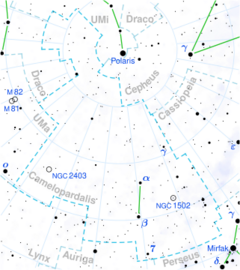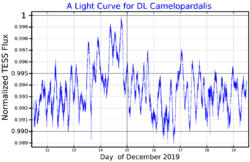Astronomy:1 Camelopardalis
| Observation data {{#ifeq:J2000|J2000.0 (ICRS)|Epoch J2000.0 Equinox J2000.0 (ICRS)| Epoch J2000 [[Astronomy:Equinox (celestial coordinates)|Equinox J2000}} | |
|---|---|
| Constellation | Camelopardalis |
| 1 Cam A | |
| Right ascension | 04h 32m 01.841s[1] |
| Declination | +53° 54′ 39.02″[1] |
| Apparent magnitude (V) | 5.77[2] |
| 1 Cam B | |
| Right ascension | 04h 32m 00.915s[3] |
| Declination | +53° 54′ 45.35″[3] |
| Apparent magnitude (V) | 6.803[2] |
| Characteristics | |
| 1 Cam A | |
| Spectral type | O9.7IIn[4] |
| U−B color index | −0.73[5] |
| B−V color index | +0.18[5] |
| Variable type | SPB?[6] |
| 1 Cam B | |
| Spectral type | B1IV:[7] |
| U−B color index | −0.70[5] |
| B−V color index | +0.16[5] |
| Astrometry | |
| 1 Cam A | |
| Proper motion (μ) | RA: +2.775[1] mas/yr Dec.: −3.783[1] mas/yr |
| Parallax (π) | 1.2630 ± 0.0486[1] mas |
| Distance | 2,580 ± 100 ly (790 ± 30 pc) |
| 1 Cam B | |
| Proper motion (μ) | RA: +0.775[3] mas/yr Dec.: −3.211[3] mas/yr |
| Parallax (π) | 1.1211 ± 0.0462[3] mas |
| Distance | 2,900 ± 100 ly (890 ± 40 pc) |
| Absolute magnitude (MV) | −5.53[8] |
| Details | |
| 1 Cam A | |
| Luminosity | 4,365[9] L☉ |
| Surface gravity (log g) | 3.65[9] cgs |
| Temperature | 29,800[9] K |
| Rotational velocity (v sin i) | 275[10] km/s |
| 1 Cam B | |
| Luminosity | 1,995[11] L☉ |
| Temperature | 29,512[11] K |
| Rotational velocity (v sin i) | 11[11] km/s |
| Age | <20[8] Myr |
| Other designations | |
| Database references | |
| SIMBAD | data |
| 1 Cam A | |
| 1 Cam B | |
1 Camelopardalis (1 Cam) is a double star system in the constellation Camelopardalis. Its combined apparent magnitude is 5.56 and it is approximately 800 parsecs (2,600 ly) away.
The 1 Camelopardalis system is part of the Camelopardalis OB1 stellar association, which is 820 pc away.[12] 1 Camelopardalis A is a hot massive star which has evolved away from the main sequence to become a giant. 1 Camelopardalis B is 10" away and is probably an early B class subgiant.
There is an 11th magnitude star 150" away.[13] It has been considered to be a member of a triple system,[12] but Gaia observations show it to be an unrelated background object.[14]
1 Camelopardalis A is a variable star with a small amplitude. It has a likely period of 0.22132 days and is thought to be a β Cephei variable or slowly pulsating B-type star.[16] Hipparcos photometry shows an amplitude of 0.035 magnitudes.[17] It has a rotational velocity of 275 km/s, one of the highest known.[10]
References
- ↑ 1.0 1.1 1.2 1.3 1.4 Brown, A. G. A. (2021). "Gaia Early Data Release 3: Summary of the contents and survey properties". Astronomy & Astrophysics 649: A1. doi:10.1051/0004-6361/202039657. Bibcode: 2021A&A...649A...1G. Gaia EDR3 record for this source at VizieR.
- ↑ 2.0 2.1 Høg, E.; Fabricius, C.; Makarov, V. V.; Urban, S.; Corbin, T.; Wycoff, G.; Bastian, U.; Schwekendiek, P. et al. (2000). "The Tycho-2 catalogue of the 2.5 million brightest stars". Astronomy and Astrophysics 355: L27. Bibcode: 2000A&A...355L..27H.
- ↑ 3.0 3.1 3.2 3.3 3.4 Brown, A. G. A. (2021). "Gaia Early Data Release 3: Summary of the contents and survey properties". Astronomy & Astrophysics 649: A1. doi:10.1051/0004-6361/202039657. Bibcode: 2021A&A...649A...1G. Gaia EDR3 record for this source at VizieR.
- ↑ Sota, A; Apellániz, J. Maíz; Morrell, N. I; Barbá, R. H; Walborn, N. R; Gamen, R. C; Arias, J. I; Alfaro, E. J (2014). "The Galactic O-Star Spectroscopic Survey (GOSSS). II. Bright Southern Stars". The Astrophysical Journal Supplement Series 211 (1): 10. doi:10.1088/0067-0049/211/1/10. Bibcode: 2014ApJS..211...10S.
- ↑ 5.0 5.1 5.2 5.3 Hoffleit, D.; Warren, W. H. (1995). "VizieR Online Data Catalog: Bright Star Catalogue, 5th Revised Ed. (Hoffleit+, 1991)". VizieR On-line Data Catalog: V/50. Originally Published in: 1964BS....C......0H 5050. Bibcode: 1995yCat.5050....0H.
- ↑ Samus, N. N. et al. (2009). "VizieR Online Data Catalog: General Catalogue of Variable Stars (Samus+ 2007-2013)". VizieR On-line Data Catalog: B/GCVS. Originally Published in: 2009yCat....102025S 1. Bibcode: 2009yCat....102025S.
- ↑ Lutz, T. E; Lutz, J. H (1977). "Spectral classification and UBV photometry of bright visual double stars". The Astronomical Journal 82: 431. doi:10.1086/112066. Bibcode: 1977AJ.....82..431L.
- ↑ 8.0 8.1 Westin, T. N. G. (1985). "The local system of early type stars - Spatial extent and kinematics". Astronomy and Astrophysics Supplement Series 60: 99. Bibcode: 1985A&AS...60...99W.
- ↑ 9.0 9.1 9.2 Holgado, G.; Simón-Díaz, S.; Haemmerlé, L.; Lennon, D. J.; Barbá, R. H.; Cerviño, M.; Castro, N.; Herrero, A. et al. (2020). "The IACOB project. VI. On the elusive detection of massive O-type stars close to the ZAMS". Astronomy and Astrophysics 638: A157. doi:10.1051/0004-6361/202037699. Bibcode: 2020A&A...638A.157H.
- ↑ 10.0 10.1 Cazorla, Constantin et al. (2017). "Chemical abundances of fast-rotating massive stars. I. Description of the methods and individual results". Astronomy and Astrophysics 603: A56. doi:10.1051/0004-6361/201629841. Bibcode: 2017A&A...603A..56C.
- ↑ 11.0 11.1 11.2 Simón-Díaz, S.; Godart, M.; Castro, N.; Herrero, A.; Aerts, C.; Puls, J.; Telting, J.; Grassitelli, L. (2017). "The IACOB project . III. New observational clues to understand macroturbulent broadening in massive O- and B-type stars". Astronomy and Astrophysics 597: A22. doi:10.1051/0004-6361/201628541. Bibcode: 2017A&A...597A..22S.
- ↑ 12.0 12.1 Straižys, V.; Laugalys, V. (2007). "Young Stars in the Camelopardalis Dust and Molecular Clouds. I. The Cam OB1 Association". Baltic Astronomy 16: 167–182. Bibcode: 2007BaltA..16..167S.
- ↑ Mason, B. D. et al. (2014). "The Washington Visual Double Star Catalog". The Astronomical Journal 122 (6): 3466–3471. doi:10.1086/323920. Bibcode: 2001AJ....122.3466M.
- ↑ Brown, A. G. A. (2021). "Gaia Early Data Release 3: Summary of the contents and survey properties". Astronomy & Astrophysics 649: A1. doi:10.1051/0004-6361/202039657. Bibcode: 2021A&A...649A...1G. Gaia EDR3 record for this source at VizieR.
- ↑ "MAST: Barbara A. Mikulski Archive for Space Telescopes". Space Telescope Science Institute. https://mast.stsci.edu/portal/Mashup/Clients/Mast/Portal.html.
- ↑ Jerzykiewicz, M. (1993). "Three known and twenty-two new variable stars of early spectral type". Astronomy and Astrophysics Supplement Series 97: 421. Bibcode: 1993A&AS...97..421J.
- ↑ Lefèvre, L; Marchenko, S. V; Moffat, A. F. J; Acker, A (2009). "A systematic study of variability among OB-stars based on HIPPARCOS photometry". Astronomy & Astrophysics 507 (2): 1141. doi:10.1051/0004-6361/200912304. Bibcode: 2009A&A...507.1141L. https://hal.science/hal-03742152/file/aa12304-09.pdf.
 |



